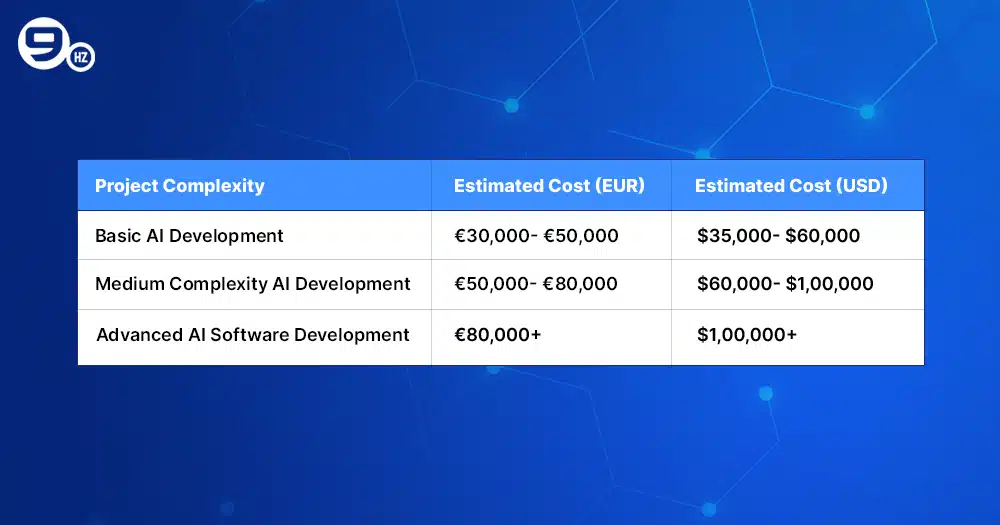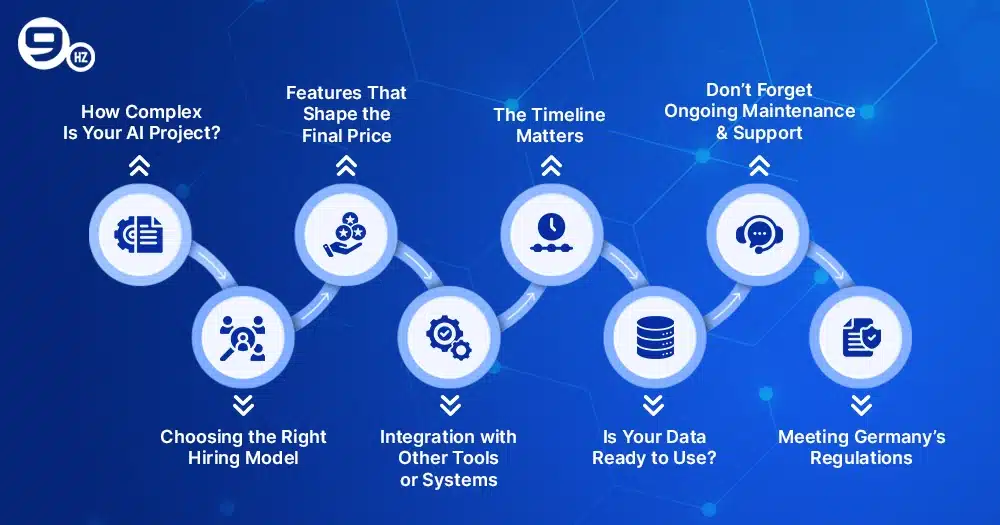Are you a business owner who has heard a lot about AI but is concerned about the investment to leverage this amazing technology?
AI development cost in Germany doesn’t always begin from millions of dollars. Artificial intelligence has reshaped the way tasks are executed across industries. From generating content to crafting personalized strategies and offering personalized customer support, AI has brought seamlessness with efficiency. Walking into 2025, this technology is no longer an option but a necessity for businesses to navigate a sustainable future. According to Statista, more than 32% of businesses are already using AI in their operations, while many more are planning to implement it soon.
However, most of the businesses press the pause button as soon as they think about the big expenses associated with AI implementation. As a leading AI Development company in Germany, we have brought some insights to eradicate all the myths associated with the AI development cost in Germany.
The cost of AI development in Germany can range from $50,000- $500,000 (€40,000- €400,000) and even more. The reason behind the statement is that the exact cost is highly influenced by a range of factors, including the particular business requirements. In this article, we will understand all about the AI development cost in Germany in 2025, along with the influencing factors, and how you can control the costs.
What is the Average Cost to Build AI Software in Germany?
Talking about the average cost, it falls anywhere around $150,000 (€100,000) to build a full-fledged AI solution with advanced capabilities. However, the exact amount is entirely subject to the specific business requirement and client preferences.
There are many other factors, like the complexity of the project, third-party integrations, types of technologies used, timeline of development, team size, hiring models, and much more, that can help you control your costs. At the same time, taking the right decision about the features to integrate into the solution also plays a significant role in smartly managing the costs.
Here, we have presented the estimated AI development cost in Germany based on different influencing factors-
1. Cost to Develop an AI System According to Project Complexity
An AI software with fewer complexities and basic functionalities can be developed at a lower cost, while an advanced software with increased complexities requires a bigger investment. For instance, if you are looking for a simple chatbot that can send pre-defined messages to customers, it can be developed within €40,000. On the other hand, if you are looking to build an agentic AI solution that can automate and streamline different business processes, the cost will be significantly higher.
| Project Complexity | Estimated Cost (EUR) | Estimated Cost (USD) |
|---|---|---|
| Basic AI Development | €30,000- €50,000 | $35,000 – $60,000 |
| Medium Complexity AI Development | €50,000- €80,000 | $60,000 – $100,000 |
| Advanced AI Software Development | €80,000+ | $100,000+ |
2. Cost to Build an AI Solution for Different-Sized Businesses
Different business sizes have varying technology requirements, and thus, the cost of AI development also changes. For example, a small firm looking for an email automation system that can connect with the defined stakeholders will not require much investment. On the other hand, an enterprise-grade firm with thousands of employees looking to implement an AI-based security system that controls accessibility to information and documents will cost more, as it will be managing more people and complex business processes.
| Business Sizes | Estimated Cost (EUR) | Estimated Cost (USD) |
|---|---|---|
| Small Businesses | €15,000- €30,000 | $17,000-$40,000 |
| Medium Businesses | €30,000- €55,000 | $40,000-$67,000 |
| Large Businesses | €80,000- €160,000 | $100,000-$200,000 |
3. Cost to Build an AI System for Different Industries
Artificial intelligence has been reshaping businesses across industries. While customer support firms are leveraging this technology to offer 24*7 support to their customers, FinTech institutions are considering AI as a reliable option to elevate their security and privacy standards. However, it is important to understand that the AI development cost in Germany for different industries varies significantly due to the varying needs and preferences. Let’s have a look at the estimated cost of AI development for different industries-
| Industry | Estimated Cost (EUR) | Estimated Cost (USD) |
|---|---|---|
| Healthcare | €50,000- €700,000 | $60,000- $80,000 |
| Real Estate | €30,000- €600,000 | $40,000- $70,000 |
| Logistics & Supply Chain | €40,000- €65,000 | $50,000- $80,000 |
| eCommerce | €20,000- €60,000 | $30,000- $70,000 |
| Education | €20,000- €60,000 | $30,000- $70,000 |
| Mnaufacturing | €30,000- €70,000 | $40,000- $80,000 |
| Finance | €40,000- €80,000 | $50,000- $90,000 |
4. Cost to Develop an AI System based on App Types.
Different types of apps help businesses to leverage AI features and functionalities. For example, a facial recognition app or software allows businesses to add an extra and strong layer of security. Similarly, a predictive analytics app will allow a manufacturing business to analyze the market demand and thus estimate the stock amount that should be manufactured to avoid stockouts and overstocks.
| App type | Estimated Cost (EUR) | Estimated Cost (USD) |
|---|---|---|
| AI Chatbot | €40,000- €60,000 | $60,000- $80,000 |
| Recommendation System | €40,000- €70,000 | $50,000- $90,000 |
| Speech Recognition Software | €30,000- €60,000 | $40,000- $70,000 |
| Predictive Analytics Software | €30,000- €70,000 | $40,000- $80,000 |
| AI Agents | €20,000- €60,000 | $30,000- $70,000 |
| Agentic AI Solution | €40,000- €70,000 | $50,000- $80,000 |
| Computer Vision Software | €20,000- €60,000 | $30,000- $70,000 |
5. AI Development Cost in Germany for Different Project Phases
The AI development cost in Germany is distributed throughout the product development lifecycle as it significantly requires consistent support of human as well as technical resources. The AI development process consists of several phases, like ideation, designing, model training, testing, deployment, and much more. Here is the estimated cost segregation throughout the project phases.
| Different App Phases | Estimated Cost (EUR) | Estimated Cost (USD) |
|---|---|---|
| Discovery & Planning | €1,500- €4,000 | $2,000- $5,000 |
| UI/UX Design | €8,000- €12,000 | $10,000- $15,000 |
| Core Development | €12,000- €16,000 | $15,000- $20,000 |
| AI Engineering | €16,000- €25,000 | $20,000- $30,000 |
| Quality Testing | €8,000- €12,000 | $10,000- $15,000 |
| Deployment | €4,000- €6,000 | $5,000- $8,000 |
6. AI System Development Cost in Germany Based on the Development Model
There are two types of development models that businesses can choose from. The first one is custom AI development that allows businesses to build an AI solution from scratch while imparting each feature and overall design according to their personal preferences. Another one is a white-label solution that focuses on altering a ready-made solution according to a business’s needs, with limited customization options. A custom AI solution requires more time to develop, while a white-labeled solution can be developed comparatively faster.
| Development type | Estimated Cost (EUR) | Estimated Cost (USD) |
|---|---|---|
| Custom AI Development | €40,000- €80,000 | $60,000- $100,000 |
| White Label Solution | €30,000- €50,000 | $40,000- $60,000 |
8 Key Factors Affecting the Cost of AI Development in Germany
As interpreted in the above section, the AI development cost in Germany is influenced by several factors that can increase or decrease the overall expenses. Having an understanding of these factors helps significantly in controlling the costs without compromising the quality of app development. Here are the main factors that influence the cost to develop an AI system in Germany-
1. How Complex Is Your AI Project?
This is a core factor and one of the biggest factors that can influence your AI development cost in Germany. A basic app with fewer functionalities costs less compared to a project with numerous complexities and technological integrations. The reason behind the statement is that complex AI projects require huge infrastructural costs, third-party services, longer development time, and more resources. Arranging all these things requires more investment than ultimately increases the development costs.
2. Choosing the Right Hiring Model
There are a number of hiring models that businesses can choose from in order to build an AI app in Germany. It includes dedicated hiring, time and resources, outsourcing, freelance, hybrid, and much more. However, each of these hiring models is curated for specific business requirements, and thus, the costs also differ. For example, a dedicated team hiring model is very expensive, as it is ideal for complex and long-term projects. On the other hand, freelance hiring saves a lot of cost but might also impact the overall project quality.
3. Features That Shape the Final Price
There is no doubt that features and functionalities play the key role in attracting the target audience while increasing the usability of the solution. Thus, it is never a good idea to compromise on the essential features to save some pounds. However, it is also important that you prioritize the right features for your AI solutions that deliver the worth of investment, so that you don’t end up wasting money on features that are not required.
4. Integration with Other Tools or Systems
API and third-party integration are performed to bring some unique and highly advanced features into the solution. While some of the third-party service providers offer the insights and functionalities for free, many others charge for the same. Hence, opting for the free providers while AI development will help you reduce the cost, while integrating the paid APIs will increase the development budget.
5. The Timeline Matters
The longer development timeline for the AI app requires more cost, and vice versa. The project timeline is directly proportional to the cost, as longer projects tend to require more resources while engaging the development team for a longer period. At the same time, when clients opt for a time and resource hiring model, the project cost is directly calculated according to the time spent by the development team while working on the project.
6. Is Your Data Ready to Use?
The efficiency of an AI software is entirely dependent on the data that has been used to train the AI model. Therefore, if the data is already available to the client, it will reduce the development cost as well as the timeline. On the other hand, if the data is required to be purchased from external sources, it attracts additional costs. At the same time, processes like fine-tuning high-quality data and removing the biasness are also associated with some costs that have to be borne by the client.
7. Don’t Forget Ongoing Maintenance & Support
A full-fledged IT solution requires post-deployment maintenance to actively monitor the performance of the application and ensure that it is executing according to expected standards. At the same time, post-deployment support helps to remove bugs, add new features, and provide periodic updates to the technological solution. However, you must understand that this maintenance and support also add up to the overall AI development cost in Germany.
8. Meeting Germany’s Regulations
There are strict laws for the use of artificial intelligence in different countries and states, which makes it highly complicated to ensure relevant laws and legislation while building a mobile app. For example, a healthcare AI app must comply with HIPAA and TGA compliance in order to be available in the market. Ensuring regulatory compliance requires both technical as well as human support. A lot of regulatory compliance and legislation can sometimes increase the cost of AI development in Germany.
5 Proven Strategies to Reduce the Cost of AI System Development in Germany
Opting for a low-performing AI app to save on the development costs is never a good idea, as it will never be able to fulfill the expectations and use cases. On the other hand, knowing some key practices that can help reduce the cost of AI development in Germany can be a better approach.
1. MVP Approach
This is one of the best and most used approaches preferred by enterprises as well as development companies to control the AI development cost in Germany. According to this strategy, the client can opt for building a minimum viable product instead of a complete product and launch it among the stakeholders. This practice helps significantly to assess the users’ response to the product and thus identify the areas for improvement. The client doesn’t need to invest in full-scale development, which saves a significant cost of unnecessary feedback implementation.
2. Define Project Objectives
Having clear project objectives and ultimate goals plays a significant role in ensuring that efforts and investments are made in the right direction. It helps to decide the number and types of features, functionality, third-party integration, timeline, and overall costs that eliminate the chances of miscellaneous costs. At the same time, having clear objectives leaves no space for rework in the later stages as the product aligns with the expectation in one go.
3. Choose the Right Hiring Model
Different types of hiring models allow you to engage with developers. It includes dedicated hiring, freelance, outsourcing, hybrid, fixed price, and hourly basis. Each of the hiring models is curated for a specific type and nature of project. Choosing the right hiring model according to your particular project will ensure thorough IT support during the project without wasting money.
4. Source High Quality Data
Whether you are using the internal data of the company or sourcing it from a third-party platform, make sure it is high-quality data. There is no doubt that higher quality will also attract higher costs. But, the most important thing is that it will save you significant costs as well as time in fine-tuning, cleansing, and filtering the data for the model training.
5. Subscribe for Cloud Strategy
If you are building an AI solution while focusing on scalability and long-term functionalities, it is best to opt for cloud infrastructure as compared to an on-premise solution. The reason behind the statement is that cloud-based solutions tend to be more scalable and require the least maintenance over time. At the same time, it is easier to make changes and provide updates in the cloud-based AI solutions.
How The Ninehertz Can Help You Build AI Software Cost-Effectively?
AI solutions are nothing less than a magic wand for business in modern times. However, the most important thing is the AI development company in Germany that you choose for your project. While a good development partner will help you build an AI solution that aligns with your vision and business needs, an inefficient developer might drain all your money and time to offer you nothing in return.
So, NineHertz is a leading name in the AI landscape with an experience of 15+ years. We have helped 100+ businesses from diverse industries to integrate Industry 4.0 technologies into their operations to embrace seamlessness with increased revenue. Here are some of our core competencies that make us the best option for building your AI software cost-effectively.
1. Free Consultation
It is important that you understand your idea and business needs. Therefore, we offer a free consultation to businesses looking to integrate AI in their operations. This consultation session focuses on collaborative brainstorming and outlining the roadmap. At the same time, we also offer the estimation of time and resources that will be required for the project.
2. Seasoned Experts
We have a team of 250+ developers, each carrying years of experience in their respective domains. The NineHertz makes sure that only the top talent and well-versed experts are working on your project to maintain the quality standards throughout the project lifecycle.
3. Versatile to Vast Technologies
Not only AI, The NineHertz carries the exceptional capabilities to work on diverse industry 4.0 technologies like machine learning, metaverse, blockchain, augmented reality, virtual reality, and much more. It allows us to build immersive solutions according to particular client preferences that drive the best results.
4. Industry Specific Expertise
We work with industry-specific experts who better understand the challenges that occur in different industries daily. Thus, it becomes easier for our developers to understand the pain points of the businesses and curate the solution accordingly. Moreover, the industry-specific expertise also helps us to prioritize the right features, increasing the return on investment.
5. Non-Disclosure Agreement
We respect the privacy of all the information about the client and the project. Therefore, we keep a non-disclosure agreement (NDA) at the center of the development process, which ensures that any information related to the client or the project will not be shared with any third party without the proper mutual consent.
6. Cost Efficiency
The team at The NineHertz is well familiar with the practices that help to save costs without affecting the overall quality of the outcomes. Our guidance toward the feature selection, hiring model, MVP development, and designing curation allows the client to make the right decision from the beginning of the project and thus save significantly in the later stages.
7. Maintenance and Support
We offer ample maintenance and support after the deployment of the project, which ensures that your software works seamlessly over a longer time period. Our support services help to integrate new features, redesign the interface, provide periodic updates, and make improvements according to changing users’ requirements.
Conclusion
Artificial intelligence has been transforming businesses in Germany by automating operations, increasing accuracy, and enhancing overall efficiency. However, the AI development cost in Germany is something that concerns most business owners while making the decision. While the cost of AI development in Germany ranges between $50,000- $500,000 (€40,000- €400,000), it can further be controlled by implementing the right practices.
If you are also looking to build an AI solution and automate your processes, The NineHertz invites you for a free consultation session where we can discuss the key challenges and curate a personalized roadmap. Connect today to transform your idea into an AI-powered, high-performing product.
Frequently Asked Questions (FAQs)
What is the average cost of AI development in Germany?
Answer- The average cost of AI development in Germany ranges between $50,000- $500,000 (€40,000- €400,000)and even more. The exact AI development cost in Germany depends on a range of factors like data availability, hiring model, project complexity, features, maintenance & support, and much more.
How long does it take to develop an AI solution in Germany?
Answer- Generally, it takes almost 6-8 months to build an AI solution in Germany. However, the exact timeline might vary on the basis of different components, including team size, hiring model, feedback and rework, features, third-party integration, API integration, etc.
What factors most significantly impact AI development costs?
Answer- Following are the factors that significantly impact the AI development costs-
- Project complexity
- Hiring model
- Data availability
- Team expertise
- Technology stack
- Development timeline
- Maintenance and support
- Legal compliances, etc.
Can small businesses afford AI development in Germany?
Answer- AI development has nothing to do with the organization size, as the development costs entirely depend on the business requirements. The AI solutions for small organizations often cost significantly less as compared to building an AI solution for enterprise-level companies. So, it is affordable for small businesses to implement AI in their solutions.
What is maintenance and support after deployment?
Answer- Post-deployment maintenance and support is the service that ensures the IT support for continuous performance tracking, feature integration, periodic updates, and bug mitigation processes. It promises the long-term optimal performance of the solution so that AI software can comply with changing users’ needs.











